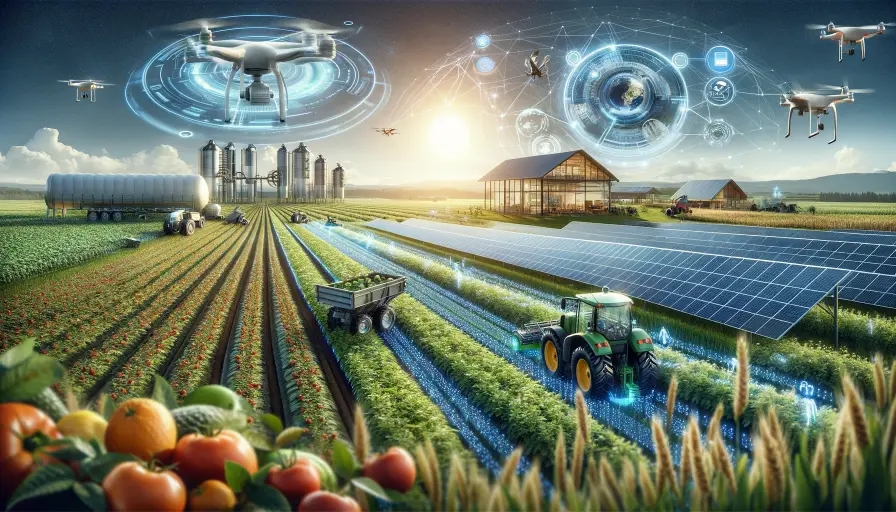AI’s role in agriculture is poised to transform the sector significantly through several innovative approaches, leading to increased efficiency, sustainability, and productivity. Here are some ways AI is expected to shape the future of agriculture:
- Precision Farming: AI enables precision agriculture, allowing farmers to optimize their inputs such as water, fertilizer, and pesticides, thereby increasing efficiency. Through data analytics, AI can analyze soil conditions, weather data, and plant health to make precise recommendations on the optimal planting time and crop rotation strategies.
- Automated Machinery: With advancements in AI, we’ll see more autonomous tractors, drones, and robotic systems performing tasks like planting, weeding, and harvesting. These machines can operate around the clock, reducing labor costs and human error while increasing productivity.
- Disease and Pest Detection: AI-powered systems can monitor crop health in real-time, using image recognition technologies to detect diseases and pest infestations early on. This early detection allows for timely intervention, minimizing crop damage and reducing the need for chemical treatments.
- Yield Prediction and Crop Management: AI algorithms can predict crop yields more accurately by analyzing data from various sources, including satellite images, weather stations, and soil sensors. These predictions help farmers make informed decisions about managing their crops and optimizing harvest times.
- Supply Chain Optimization: AI can streamline the agricultural supply chain, from production to distribution. By predicting demand and optimizing logistics, AI reduces waste, improves efficiency, and ensures fresher produce reaches consumers faster.
- Sustainable Practices: AI contributes to sustainable agriculture by enabling more efficient use of resources, thus reducing the environmental footprint. For instance, precision farming techniques can significantly reduce the amount of water and fertilizers used, while automated weed control can minimize the need for herbicides.
- Genetic Editing and Crop Improvement: AI aids in analyzing genetic data from plants, accelerating the breeding of crops that are more resilient to climate change, diseases, and pests. This could lead to the development of crops that yield more with fewer inputs.
- Market Insights and Economic Decisions: By analyzing market trends and data, AI can provide farmers with insights into the best times to sell their produce, what crops to plant for the highest profitability, and how to diversify their agricultural practices to mitigate risk.
While these advancements promise numerous benefits, they also come with challenges, including the need for significant investments in technology, concerns about data privacy, and the risk of job displacement in traditional farming roles. Moreover, the adoption of AI in agriculture must be inclusive, ensuring that smallholder and subsistence farmers also benefit from these technologies, not just large-scale operations. As AI continues to evolve, its integration into agriculture will likely be a key factor in addressing global food security challenges in the face of a growing population and changing climate.
The integration of AI and General AI into agriculture and farming brings numerous advantages, as mentioned earlier, but it also raises several concerns and disadvantages that need careful consideration:
- Job Displacement: One of the primary fears is the potential for AI-driven machinery and systems to displace jobs traditionally held by humans. While automation can reduce labor costs and increase efficiency, it also poses a risk to employment in rural communities where agriculture plays a significant economic role.
- Data Privacy and Security: The use of AI in agriculture often involves collecting and analyzing vast amounts of data, including sensitive information about farms and their operations. This raises concerns about data privacy and the security of this information against cyber attacks.
- Dependence on Technology: Heavy reliance on AI technologies could lead to situations where farmers lose traditional farming knowledge and skills. There’s also the risk of becoming dependent on a few technology providers, which could lead to monopolistic practices and reduced bargaining power for farmers.
- High Initial Costs: The adoption of AI technology in agriculture requires significant initial investment in terms of both money and time. This can be a major barrier for small-scale farmers and may lead to a widening gap between large, technologically advanced farms and smaller, resource-constrained ones.
- Accessibility and Digital Divide: There’s a concern that the benefits of AI in agriculture might not be evenly distributed, especially across different regions of the world. Farmers in developing countries, or those without access to the necessary infrastructure and training, might be left behind, exacerbating existing inequalities.
- Environmental Impact: While AI has the potential to support more sustainable farming practices, the production and operation of high-tech AI equipment also consume resources and energy. There’s a need to carefully balance the environmental benefits against the carbon footprint and ecological impact of manufacturing, operating, and disposing of AI technologies.
- Ethical and Societal Concerns: The deployment of AI in agriculture raises ethical questions about the treatment of animals in automated farming environments and the impact of technological interventions on ecosystems. Moreover, there are societal concerns about the concentration of power and control over food production in the hands of technology companies rather than farmers.
- Reliability and Technical Challenges: AI systems can sometimes be prone to errors or failures, which can be disastrous in a farming context where timing and precision are crucial. Technical issues, software bugs, or inaccurate data analysis could lead to poor decision-making, affecting crop yields and farm profitability.
- Regulatory and Legal Issues: The integration of AI in agriculture also introduces regulatory and legal challenges, particularly concerning liability in case of accidents or failures. Determining responsibility for AI-driven decisions or actions remains a complex issue that requires clear legal frameworks.
Addressing these fears and disadvantages requires a multi-faceted approach, including the development of ethical AI guidelines, investment in training and education for farmers, ensuring equitable access to technology, and creating robust data protection laws. It’s crucial for the benefits of AI in agriculture to be balanced with careful consideration of the potential negative impacts, ensuring that the advancement of technology contributes positively to the future of farming and global food security.
